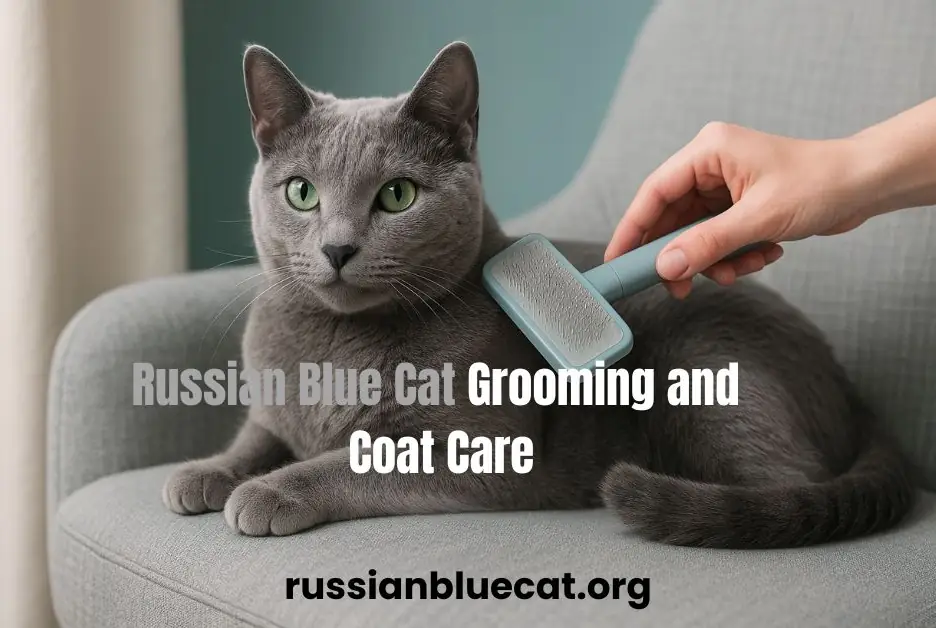The Ultimate Guide to Russian Blue Cat Care Every Owner Must Know in 2025

Introduction Welcome to the Russian Blue Cat Care Center
Each pet has a story behind it, but few are shrouded in so much mystery and refinement as the Russian Blue Cat. With their dazzling blue-gray coats and entrancing emerald eyes, these cats have won the hearts of cat lovers for centuries. They are level-headed, devoted, wise, and incredibly loving and yet, maintain a dignified air of independence which makes them stand out from the rest.
Russian Blue Cat Care Guide you’re currently reading is one of our Russian Blue Care Hub here at RussianBlueCat.org. We’ve established this platform with the aim of providing existing and prospective owners with all they need to care, understand, and love this incredible breed.
By the end of this guide, you’ll have a clear, step-by-step understanding of how to provide the very best for your Russian Blue Cat from grooming and diet to health and training. Think of this hub as your trusted companion in the journey of raising a healthy, happy Russian Blue.
The Story Behind Our Passion
It started with one little kitten. She was small, timid, and covered in the most luxurious coat we had ever felt. We figured she would just be another pet a friendly addition to the family. But in weeks, she had settled into our lives without much fanfare.
Guests who came over would ask:
- “What is she?”
- “Why does her hair glimmer in the light?”
- “How did you train her to be so calm?”
We came to the realization that there wasn’t a specific website online where people could know all they wanted to know about Russian Blue Cats. And so, the concept of the Russian Blue Care Hub came into play.
This Russian Blue Cat Care Guide is not just an article it’s a compassionate compilation of knowledge, tips, and expert recommendations designed to assist cat parents in offering the love and care due to these cats.
Why a Russian Blue Cat Care Guide Is Important
Special Coat & Grooming Requirements
In contrast to most cats with a single coat, the Russian Blue boasts a thick double coat that is similar in feel to velvet. It requires regular but light maintenance to remain healthy and mat-free.
Personality and Temperament
Russian Blues are aloof to strangers but strongly attached to their beloved humans. This special combination of shyness and attachment makes them happiest in quiet, stable homes.
Long Lifespan, Lifelong Responsibility
With a lifespan ranging from 15–20 years, adopting a Russian Blue Cat is a lifetime commitment. The best care decisions today will influence your cat’s happiness and health for decades to come.
This is the reason behind the Russian Blue Care Hub: to walk you through step by step in learning and taking care of this beautiful breed.
Grooming & Coat Care

The Charm of the Silvery Coat
The Russian Blue’s dense double coat is its pride and joy. Velvety-soft, thick, and icy-shining, it’s one of the primary reasons why the breed captures people’s hearts. Unlike the majority of long-haired cats, their coat is unlikely to mat, but it does still need regular grooming.
Brushing Simplified
- Weekly: A brief brushing session should do the trick.
- Shedding seasons: Spring and autumn, brush 2–3 times a week to minimize hair in your home.
- Tools to use: A rubber mitt or slicker brush is ideal. Use no harsh combs that tug on their coats.
Bathing Do’s and Don’ts
- Russian Blues do not typically require frequent baths they have coats that repel dirt and water naturally.
- If bathing must be done, use a mild cat-safe shampoo.
- Dry them well with a towel and, if necessary, a low-heat pet-safe dryer.
Nail, Ear, and Eye Care
- Cut nails every 2–3 weeks.
- Inspect ears weekly for wax or redness.
- Clean around the eyes with soft, damp cotton, if necessary.
Nutrition & Feeding

Why Diet Matters So Much
The Russian Blue Cat Care Guide lays great stress on nutrition. This breed can be inclined to overeating, so careful planning of meals is necessary.
What to Feed Your Russian Blue
- Protein First: Select foods with actual chicken, turkey, or fish as the lead ingredient.
- Balanced Diet: Make sure they receive taurine, Omega-3 fatty acids, and key vitamins.
- Wet + Dry Mix: Wet food for hydration; dry food for tooth cleaning.
Feeding Guidelines
- Kittens: 3–4 small meals a day, evenly distributed.
- Adults: 2 measured meals per day.
- Avoid free-feeding; rather, employ a puzzle feeder to slow them down and challenge their minds.
Treats & Healthy Extras
Treats are a great way to bond, but in moderation. Treats should remain below 10% of daily calories. Best treats are:
- Freeze-dried chicken or salmon.
- Catnip toys for a fun, calorie-free experience.
- Infrequent boiled fish or vet-approved treats.
Health & Wellness

Common Health Issues
Russian Blues are robust, but like all breeds, they may be subject to specific health issues:
- Hypertrophic Cardiomyopathy (HCM): Routine vet checkups are advised.
- Obesity: Balanced diet and exercise.
- Dental Problems: Brush weekly and have cleanings.
- Urinary Health: Encourage water consumption to avoid UTIs.
Vet Visits and Preventive Care
- Yearly checkups for adult cats; bi-yearly for seniors.
- Vaccinations for rabies, feline distemper, and other typical illnesses.
- Prevention from parasites (fleas, ticks, worms).
Keeping Your Cat Active
Russian Blues like playing but also adore their peaceful naps. To keep them active:
- Offer climbing areas such as cat trees.
- Play interactive games with wand or feather toys.
- Experiment with clicker training for mental stimulation.
- Promote short play sessions throughout the day.
Training & Behavior
Knowing the Russian Blue Personality
Russian Blues are usually referred to as courteous cats. They do not scratch furniture frequently nor crave constant attention, but they do enjoy intimacy with their beloved human.
They are clever and sensitive, observing mood and surroundings. Noise or a quick movement can put them on their guard, so consistency and patience are called for.
Training Tips
- Begin with trust: Allow them to settle first.
- Positive reinforcement is most effective reward the desired action with treats or play.
- Leash training: Russian Blues that are trained at an early age often enjoy supervised walks.
- Mental stimulation: Engage them in simple tricks or puzzle toys to tax their intelligent minds.
Lifestyle & Environment

Setting Up the Perfect Home
The Russian Blue Care Hub invites owners to consider their homes from the cat’s point of view. A few thoughtful changes make a huge difference:
- Soft resting places by windows for sunbathing.
- Scratching posts and cat trees to protect your furniture.
- Quiet areas where your cat can escape when overwhelmed.
Families and Other Pets
Russian Blues thrive in families where children are respectful and can adjust to life with dogs or other cats. Introductions must be gradual and pleasant, allowing them to settle in.
Traveling with a Russian Blue Cat
Travel can be upsetting for any cat, but Russian Blues will adjust with good preparation:
- Use a secure carrier with airholes.
- Begin with brief automobile excursions before extended travel.
- Pack familiar objects such as bedding or toys.
The Russian Blue Care Hub Community
This Russian Blue Cat Care Guide is only one aspect of the Russian Blue Care Hub. Beyond articles, we’re creating a community where cat enthusiasts can meet, share their experiences, and help each other.
Here’s how you can join:
- Visit our Contact Us page to send questions or feedback.
- Join our WhatsApp Channel for daily tips on Russian Blue care and cute cat content.
- Read in-depth guides and true Russian Blue owners’ stories on Russian Blue Cat.
Interesting Facts About Russian Blue Cats
- Their cheerful face comes naturally, courtesy of their ever-so-slightly upturned mouth.
- Numerous Russian Blues are left-pawed, a condition that occurs infrequently in cats.
- They are revered in Russian folklore as omens of good luck.
- They secrete fewer of the Fel d 1 protein, meaning they could be easier for people with allergies to keep.
- They are commonly referred to as the “aristocrats of the cat world” because of their graceful stance.
Frequently Asked Question Faq’s
Conclusion – A Lifelong Companion Awaits
This Russian Blue Cat Care Guide has taken you through every key aspect of caring for, training, and loving this wonderful breed. From brushing their soft double coat to dealing with their diet and ensuring long-term well-being, the path is one of joy, discovery, and companionship.
The Russian Blue Care Hub at our website was created with you in mind to deliver accurate information and bring you together with others who share your enthusiasm.
Bringing a Russian Blue Cat home is not simply adopting a pet; it’s inviting a calm, faithful, and elegant companion into your home. With proper care, your Russian Blue will live a long, healthy, and joyful life as your companion for many years to come.
So whenever you have queries, tales to tell, or just want to chat with other Russian Blue friends, don’t hesitate to contact us via our Contact Us page or join our WhatsApp community. Together, we can make sure that all Russian Blues have the love, care, and comfort they deserve.
